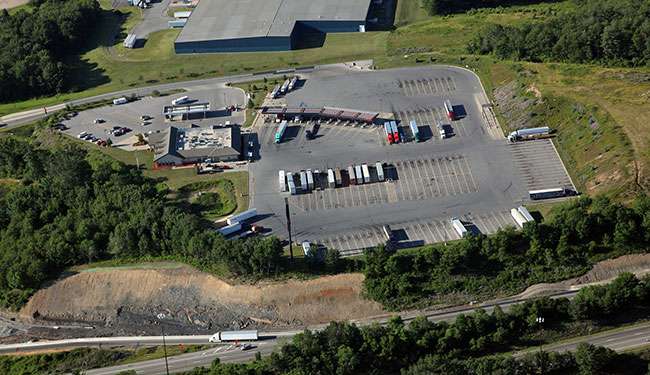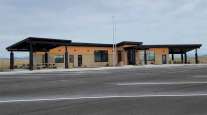Staff Reporter
PMTA Leads Innovative Pennsylvania Truck Parking Report

[Stay on top of transportation news: Get TTNews in your inbox.]
Pennsylvania transportation planners broke new ground to identify both concrete steps and priority locations for new truck parking spots in a report spearheaded by the state’s top trucking group.
Rebecca Oyler, CEO of the Pennsylvania Motor Truck Association, told Transport Topics she is excited to work with partners across the state to help implement recommendations outlined in the 50-page “Expanding Truck Parking in Pennsylvania” report.
“We also look forward to taking advantage of the data collected and recommendations provided to access funding opportunities for truck parking in the near future,” she said.
Not only did Oyler submit a proposal in September 2022 to the State Transportation Advisory Committee (TAC) requesting that potential truck parking solutions be studied, but she offered to lead such an undertaking or contribute to a team. The TAC approved the proposal and appointed her chair of the report task force.

Oyler
“TAC initiated this truck parking study to identify near-term solutions aimed at increasing truck parking capacity in Pennsylvania,” the committee noted when it released its report Dec. 13. “It is important to note at the outset that TAC recognizes that the provision of truck parking has been and will remain a private-sector opportunity. As this report demonstrates, however, there are appropriate public-sector support roles.”
Pennsylvania’s 280 parking facilities (with a combined capacity of more than 11,600 truck parking spaces) reach 105% utilization during peak overnight periods.
Help Wanted
Pennsylvania’s top 10 corridors, which are along interstates, with the greatest needs for truck parking:
• I-76 from U.S. Route 1 to I-95 in Philadelphia
• I-78 from Exit 49 (Pennsylvania Route 100) to Pennsylvania-New Jersey state line
• I-79 from the Ohio River to Exit 76 on the Pennsylvania Turnpike
• I-81 from Carlisle to the Susquehanna River
• I-81 from I-83 to I-78
• I-83 from U.S. Route 322 to I-81
• I-95 in the Philadelphia area from the Delaware state line to I-276
• Pa.Turnpike (I-76) from Exit 57 (U.S. 22) to Exit 75 (I-70)
• Pa.Turnpike (I-76) from Exit 298 (I-176) to Norristown (I-476)
• Pa. Turnpike (I-276) from Valley Forge (I-76) to I-95
Source: “Expanding Truck Parking in Pennsylvania”
Also identified are a list of second-tier corridors with the second-highest need for additional truck parking.
The central feature of the report is the creation of a collaborative problem-solving framework that lists from two to four recommendations to overcome each of six barriers.
For instance, for municipal/regulatory obstacle category, the solutions listed are to update land use regulations, address truck parking in county/local comprehensive plans and foster municipal involvement.
Among the four potential solutions to the problem of having appropriate truck parking sites are to integrate truck parking with economic development projects, repurpose state-owned surplus properties and identify multiple industrial sites offering potential shared parking and staging areas.
Other suggestions were listed to overcome problems with state/federal policy, the cost of real estate, institutional initiatives and community/quality of life concerns.
“A state DOT [department of transportation] is best suited to serve as a facilitator or convenor among other public- and private-sector interests (commercial truck stop operators, industrial developers, municipal governments, public safety officials, etc.) to help facilitate the development of new parking capacity beyond its own infrastructure,” the report stated.
ERoad's Craig Marris gives advice on carving out a practical, effective road map to a greener and more efficient fleet. Tune in above or by going to RoadSigns.ttnews.com.
Oyler said TAC’s backing of the report and its recommendations underscore that state transportation leaders recognize that the truck parking problem affects more than just trucks, and solutions involve partners both in and outside the industry.
“The study accomplishes what were the two primary goals. First, it creates an objective framework to prioritize areas where truck parking is most needed and then applies that framework to existing roadways, also establishing how the framework will determine future priorities. Second, it goes beyond previous studies and recommends 19 specific steps to take to address the issue, both in the public and private sectors,” Oyler said.
“[The study also] identifies and educates other stakeholders who will be key partners, and it establishes truck parking as an ongoing priority by giving the state important tools to continue to make progress in the future by establishing PennDOT as an executive sponsor of the issue,” she added.
Want more news? Listen to today's daily briefing below or go here for more info:





